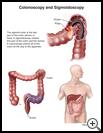
Sigmoidoscopy
________________________________________________________________________
KEY POINTS
- A sigmoidoscopy uses a scope put through your rectum to examine the lower part of your intestines.
- It can help check for cancer, or help find the cause of diarrhea, bleeding, or other problems.
- You will be given instructions for clearing bowel movements from your intestines. Be sure to follow instructions, including what types of food and drink you can have.
- After the exam, you will need to stay until you are awake and alert enough to be driven home.
________________________________________________________________________
What is sigmoidoscopy?
Sigmoidoscopy is an exam of the rectum and lower part of your intestines, also called the colon, with a thin, flexible, lighted tube and tiny camera. This scope is put through your rectum and into the lower half of your intestines.
When is it used?
Sigmoidoscopy is usually done for one of the following reasons:
- Prevention and early detection of cancer. A sigmoidoscopy can help your provider find growths (polyps) that might become cancer. The growths can then be removed before they become cancer. It can also allow your provider to find cancerous growths early, when the cancer is easier to cure.
If you are 50 to 75 years old, your healthcare provider may recommend that you have a sigmoidoscopy at least every 5 years along with a test for blood in the stool. If you have a personal or family history that increases your risk for colon cancer, your provider may recommend that you start having the test at an earlier age and have the test more often. In some cases, the test may be recommended for people older than 75.
- Diagnosis of illness. If you have symptoms of illness, such as diarrhea, blood in your bowel movements, losing weight without trying to, or belly pain, you may have this test to try to find the cause of your symptoms.
How do I prepare for this procedure?
- Plan for your care and find someone to give you a ride home after the procedure.
- You may or may not need to take your regular medicines the day of the procedure. Tell your healthcare provider about all medicines and supplements that you take. Some products may increase your risk of side effects. Ask your healthcare provider if you need to avoid taking any medicine or supplements before the procedure.
- Tell your healthcare provider if you have any food, medicine, or other allergies such as latex.
- You will be given instructions for clearing bowel movements from your intestines. Be sure to complete the bowel preparation as instructed, including what types of food and drink you can have in the days leading up to the procedure. The exam may not be done if your intestine still has bowel movement in it.
- Your provider will tell you when to stop eating and drinking before the procedure. This helps to keep you from vomiting during the procedure.
- Follow any other instructions your provider gives you.
- Ask any questions you have before the procedure. You should understand what the healthcare provider is going to do and how long it will take you to recover. You have the right to make decisions about your healthcare and to give permission for tests or procedures.
What happens during this procedure?
This procedure may be done in your healthcare provider's office, outpatient clinic, or hospital.
You will lie on a table on your side with your knees bent and drawn up to your stomach. This position makes it easier for your healthcare provider to pass the scope through your rectum and into the lower part of your intestines.
Your provider can view the images of your intestines on a computer screen. A small amount of air is passed into the lower part of your large intestine so your provider can see as much of the area as possible. The air may make you feel bloated and give you cramps, but much of the air is suctioned out at the end of the procedure.
If your provider sees anything abnormal during the procedure, he or she may take small samples of tissue through the scope for lab tests. This is called a biopsy. If a polyp or cancer is found, your provider will recommend a colonoscopy to look at the whole length of your large intestine. A colonoscopy is usually done at a later time.
A sigmoidoscopy takes about 5 to 10 minutes.
What happens after this procedure?
After the procedure, it is normal to feel some bloating or cramping. You will also need to pass gas to get rid of the extra air that was passed into the bowel during the test. Walking may help relieve the discomfort.
Follow your healthcare provider's instructions. Ask your provider:
- How and when you will get your test results
- If there are activities you should avoid and when you can return to your normal activities
- How to take care of yourself at home
- What symptoms or problems you should watch for and what to do if you have them
Make sure you know when you should come back for a checkup. Keep all appointments for provider visits or tests.
What are the risks of this procedure?
Every procedure or treatment has risks. Some possible risks of this procedure include:
- You may have infection or bleeding.
- Very rarely, other parts of your body may be injured during the procedure.
Ask your healthcare provider how these risks apply to you. Be sure to discuss any other questions or concerns that you may have.

